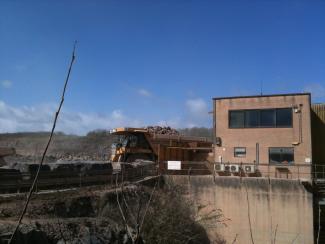
The Mendip Hills have long been exploited for stone, and a wide variety of rock types have been quarried for various purposes. Today, quarrying is an important local industry, and has had a major impact on both local communities and the environment.
Until the beginning of the 20th century, most quarries were small local concerns producing agricultural lime and building stone. The Carboniferous Limestone, Quartzitic Sandstone, Dolomitic Conglomerate and various Lower and Middle Jurassic limestones have all been quarried for building stone, and can be seen in local churches, houses and stone walls. Many of these old quarries are now important wildlife habitats and Sites of Special Scientific Interest for their geology.
By far the most valuable product today is the Carboniferous Limestone. It forms an important raw material for a wide variety of purposes, both because of its physical properties and its chemical composition. It can be used as crushed rock aggregate for the construction industry, as an essential raw material for cement and concrete manufacture and a source of building stone. It can also used in steel and glass making, sugar refining, the chemical industry, and for reducing emissions of sulphur dioxide from coal-fired power stations.